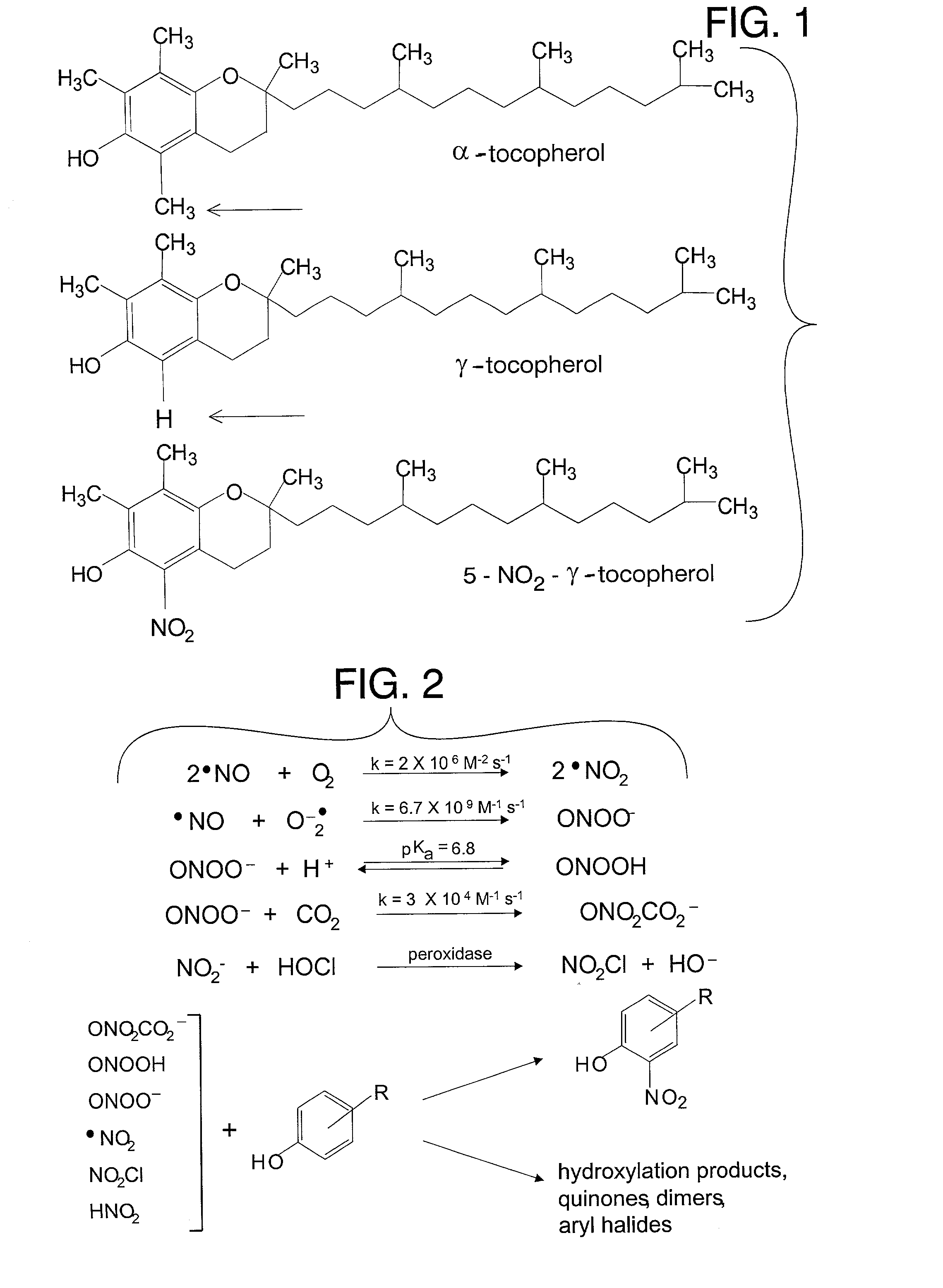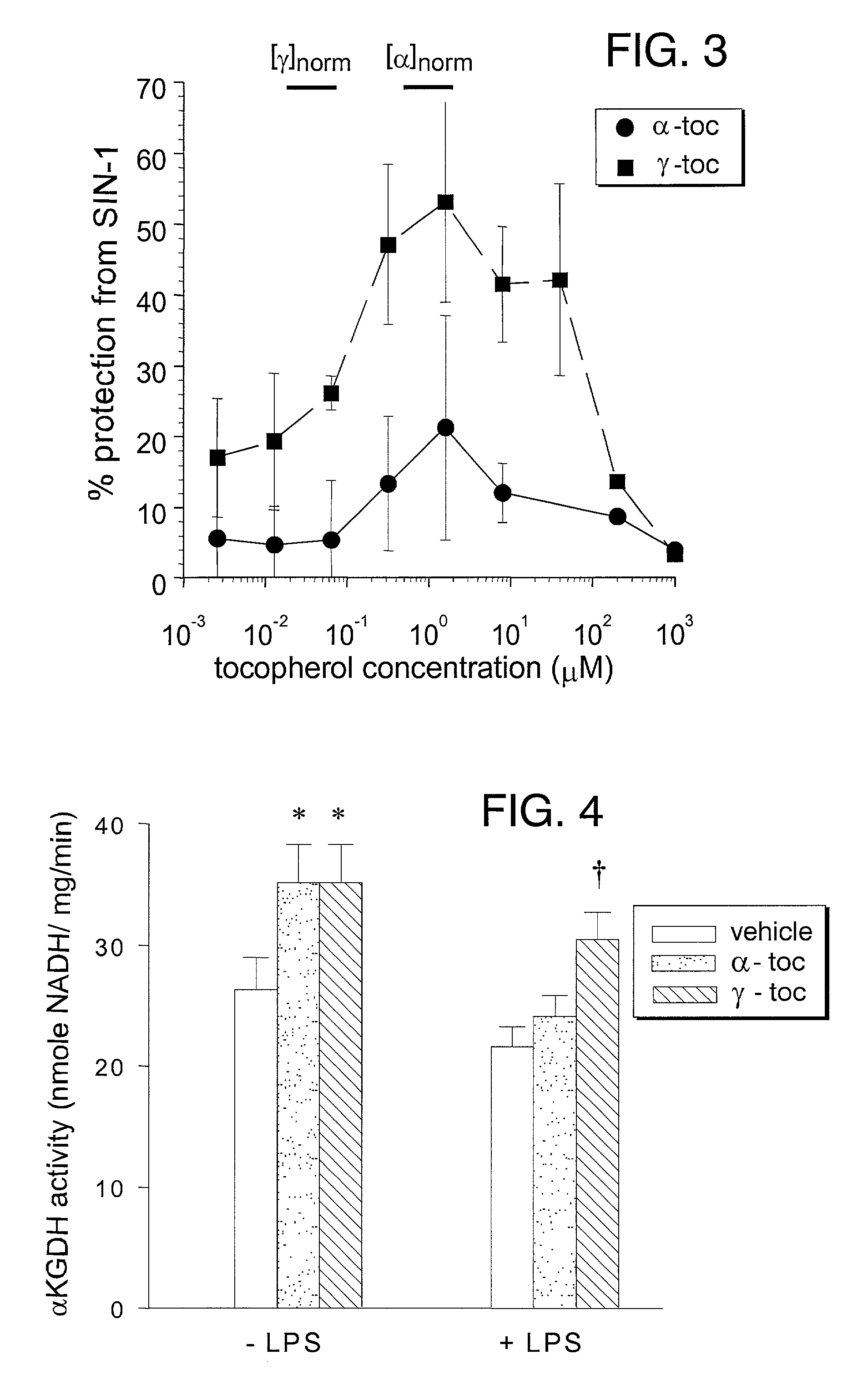Desmethyl tocopherols for protecting cardiovascular tissue
a technology of desmethyl tocopherols and cardiovascular tissue, applied in the field of desmethyl tocopherols for protecting cardiovascular tissue, can solve the problems of increased risk of occlusive thrombosis, failure to normalize, and confusion in data interpretation, so as to achieve convenient delivery and safe delivery of effective doses
- Summary
- Abstract
- Description
- Claims
- Application Information
AI Technical Summary
Benefits of technology
Problems solved by technology
Method used
Image
Examples
example 2
Demonstration of .alpha.KGDH Protection Against Nitrative Stress In Vivo by Gamma Tocopherol
[0041] Rat pups were injected intraperitoneally (I.P.) with .alpha.T or .gamma.T in an olive oil vehicle every other day for 30 days beginning 2 days after birth; control animals received vehicle only. Olive oil was chosen as a vehicle because of the low tocopherol content in this particular vegetable oil. A total of 15 mg tocopherol was delivered to each animal over the 30 day period; animal weight at the end of the period was approximately 90 g for all three groups. One half of each animal group was injected with a septic dose of LPS (2.5 mg / kg, I.P). After 24 H, animals were killed and organs collected. .alpha.KGDH was assayed in heart tissue and tocopherols were measured by HPLC-ECD / PDA. The supplementation paradigm was sufficient to approximately double the heart tissue level of both .alpha.T and .gamma.T [.alpha.T concentration=23.+-.12 ng / mg protein in controls vs. 48.+-.13 ng / mg in .a...
example 3
Demonstration of Endothelial Cell Protection by .gamma.-Tocopherol
[0042] Cultured ECV304 human endothelial cells were exposed to SIN-1 in the presence of 10 .mu.M .alpha.-T, 10 M .gamma.-T or 5 .mu.M of each (FIG. 5). Tocopherols were incubated with the cells for 19 hours prior to addition of SIN-1. Viability was assayed 24 hours later using a standard tetrazolium (MTT) reduction assay. These cells proved very resistant to damage by SIN-1; however, a 5 mM initial concentration of SIN-1 produced approximately 26% toxicity within 24 hours (N=5; FIG. 5). While .alpha.-T had no apparent effect on SIN-1 toxicity, .gamma.-T promoted viability somewhat and the combination of .gamma.-T with .alpha.-T (1:1 molar ratio) completely prevented SIN-1 toxicity (FIG. 5). The data suggest that .gamma.-T may protect cells in a way that .alpha.-T does not.
example 4
.gamma.T Scavenges Reactive Nitrogen Species in Smokers and Hypertensive Individuals
[0043] Smoking is recognized as a major contributing factor to heart disease and .gamma.-T reportedly decreases more than .alpha.-T in smokers. Hypertension is also a strong risk factor for heart disease. We have begun collection of data from "normal" subjects who do not currently have CAD, including smokers and nonsmokers, and hypertensive subjects. 11 of 54 volunteers from the Oklahoma City Veteran's Administration Hospital and the Oklahoma Medical Research Foundation indicated a current smoking habit. Seven subjects indicated a chronic hypertensive condition. As outlined in Table I, .gamma.-tocopherol tended to decrease in hypertensive subjects while nitration products tended to increase in both smokers and hypertensive subjects. This was the trend regardless of whether the tocopherol concentrations were normalized to plasma triglycerides (Table I).
1TABLE I Preliminary statistical data regarding p...
PUM
| Property | Measurement | Unit |
|---|---|---|
| Mass | aaaaa | aaaaa |
| Solubility (mass) | aaaaa | aaaaa |
| Therapeutic | aaaaa | aaaaa |
Abstract
Description
Claims
Application Information
 Login to View More
Login to View More - R&D
- Intellectual Property
- Life Sciences
- Materials
- Tech Scout
- Unparalleled Data Quality
- Higher Quality Content
- 60% Fewer Hallucinations
Browse by: Latest US Patents, China's latest patents, Technical Efficacy Thesaurus, Application Domain, Technology Topic, Popular Technical Reports.
© 2025 PatSnap. All rights reserved.Legal|Privacy policy|Modern Slavery Act Transparency Statement|Sitemap|About US| Contact US: help@patsnap.com



